The stunning scenery, the thrill of the fight as you go one-on-one with your a seriously determined fish, the air of calm and tranquility that comes before and after the big catch, it’s no wonder so many Americans love fishing. In fact, it’s estimated that some 49 million people enjoy casting off into America’s waters every year, proving to be the country’s second most popular outdoor activity besides running.
Yet of all the different types of fishing, it’s trout fishing that has millions reaching for their rods year after year, and that’s what we’re going to focus on today. In this comprehensive guide, we’ll talk about how to catch trout in a lake, in a river, and in a stream or creek.
We’ll also share our top tips on the best trout fishing gear to buy, discuss the best places to fish throughout the United States and go through everything you could possibly need to know to make the most of trout fishing season.
Speaking of which:
When is Trout Fishing Season?
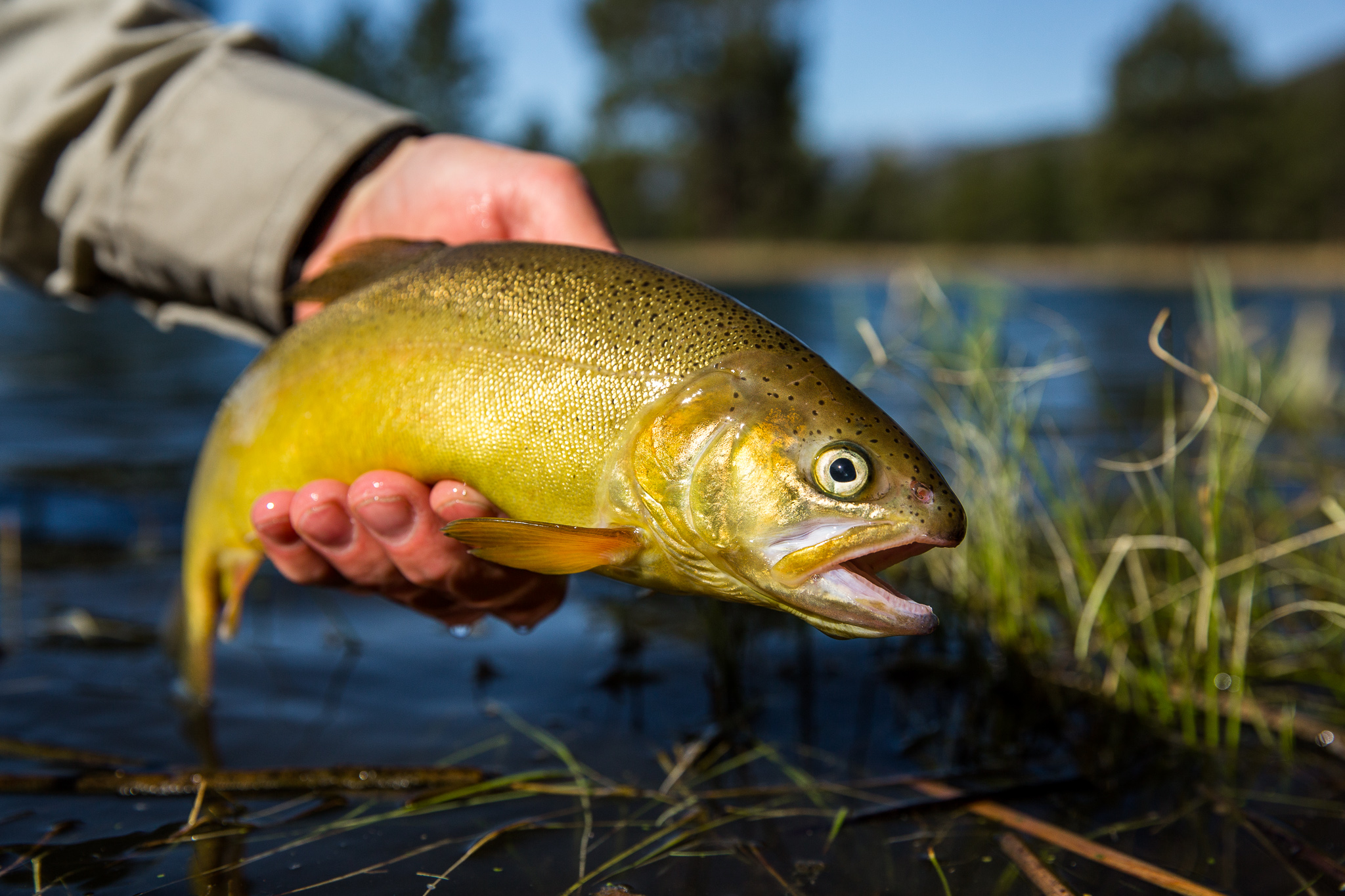
Trout fishing is often thought of as a summer activity, with tourists and hobbyists flocking to the most popular fishing spots around June and July. Yet the truth is that the season usually starts much earlier and runs much later.
In Montana, for example, the fishing season lasts from early March until the end of October. This is fairly common in other places too, so if you’re up for catching trout but don’t want to deal with overcrowded fishing spots, late spring or early Autumn will be the best time to do it.
For exact fishing season dates where you live, you can always contact your state’s Fish and Wildlife Service who will be able to help you out.
Do I Need a Fishing License to Fish for Trout?
Each US state differs in its licensing requirements for trout fishing, though it’s a relatively safe bet that you’ll require some time of permit before you can cast off into their waters.
Some websites can direct you to the right place to buy a license for the state you wish to fish in, though before you do that, there’s a few things you need to know to ensure you buy the right kind of license:
Resident vs. Out of State Fishing Licenses
If you’re planning to stay within state lines for your fishing trip, then a simple resident’s fishing license is all that you need. As long as you provide proof that you live there, most states will give you a fishing license for a lower cost than their out-of-state licenses.
Out-of-state licenses also referred to as non-resident licenses, also tend to be restricted to either daily or weekly options, whereas if you’re staying local you may be able to buy an annual or even a lifetime license.
Having said all that, don’t let the extra cost of non-resident fishing licenses put you off as in many places they still aren’t very expensive. Florida, for example, offers a non-resident three-day license for $17, or a $30 license for seven days, while in Illinois you’re looking at $15.50 for a three-day non-resident license or $31 for the seven-day deal.
Freshwater vs. Saltwater Fishing Licenses
If you’re brand new to the sport of fishing then these two terms may not mean very much to you, but they’re relatively simple to understand. Saltwater is found in seas and oceans where you’re likely to find fish like the walleye, sea bass or bluefish.
Freshwater is found in streams, rivers, lakes, and ponds. Trout is a freshwater fish, so you’ll need a freshwater fishing license.
Commercial vs. Recreational Fishing License
The last thing you need to be clear of is whether you’re buying a commercial or recreational license. If you’re fishing solely for the pure fun of it, then you’ll only need a recreational fishing license. If you’re going into business to sell your catch then you’ll need a commercial license.
How to Buy a Fishing License in the USA
Most fishing licenses can be purchased online through that state’s official department website. You should also be able to buy a license in person either from the state department office or from a local fishing equipment or sporting goods store.
What is the Best Trout Fishing Equipment to Buy?
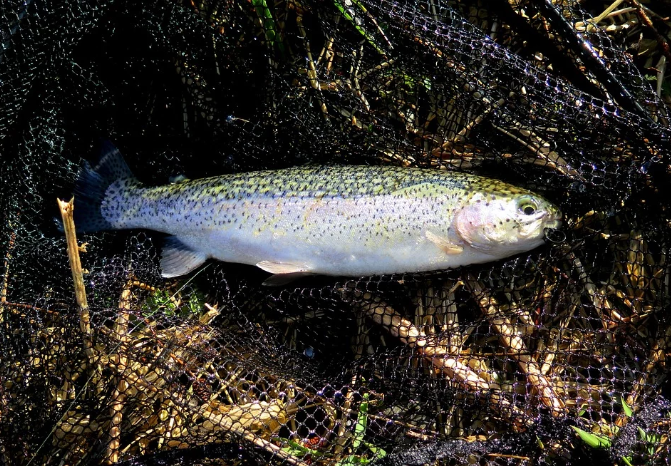
As with most hobbies, getting started with trout fishing can cost as much or as little as you’re prepared to spend.
You could buy a good quality trout fishing rod, reel, and fishing line and be on your way for under $100, though if you have more to spend you could always upgrade your kit and add other helpful tools like a landing net, line clippers, and a sturdy pair of pliers.
Below, we’ll offer a few suggestions of the best equipment to buy, including both top-of-the-line and budget-friendly options.
Best Fishing Rods for Catching Trout
Length, material, and action are the three main factors to take into consideration when choosing the best fishing rod for trout fishing. Rods built from a combination of fiberglass and graphite offer a winning combination of lightweight handling and superior durability, while fast action rods tend to the preferred choice of expert fishermen.
In terms of length, this is largely determined by the kind of water you’ll be fishing on. Naturally, expansive lakes will require a longer rod than a small stream, river or pond.
With that in mind, these are the two very best trout fishing rods that we feel offer the best combination of all three components.
Ugly Stik Elite Spinning Rod

For over forty years, the Ugly Stik brand has carved out an enviable reputation for making some of the strongest and most long-lasting fishing rods on the market.
If any of their products so perfectly epitomizes this world-class durability, it’s the Ugly Stik Elite. A well-received update to their earlier GX2 series, this high caliber model comes with 35% more graphite than its predecessors, while in our experience it is powerful enough to catch fish of up to ten pounds with snapping the tip.
As if that wasn’t enough to convince you of its quality, Ugly Stick displays remarkable confidence in their products by offering a seven-year warranty. Best of all, this best-selling spinning rod typically retails for less than $50, making it a great choice for budget-friendly fishing.
Ugly Stik Elite Specifications:
- Material: Graphite and fiberglass composite
- Length: 7 ft.
- Line Weight: 6-10 lbs
- Handle type: split
Ugly Stik Elite Pros:
- Highly durable
- Lightweight action
- Comfortable EVA grips
Ugly Stik Elite Cons:
- Limited size choice
- Stainless steel guides aren’t very well constructed
OKUMA Celilo Graphite Lightweight Trout Rod
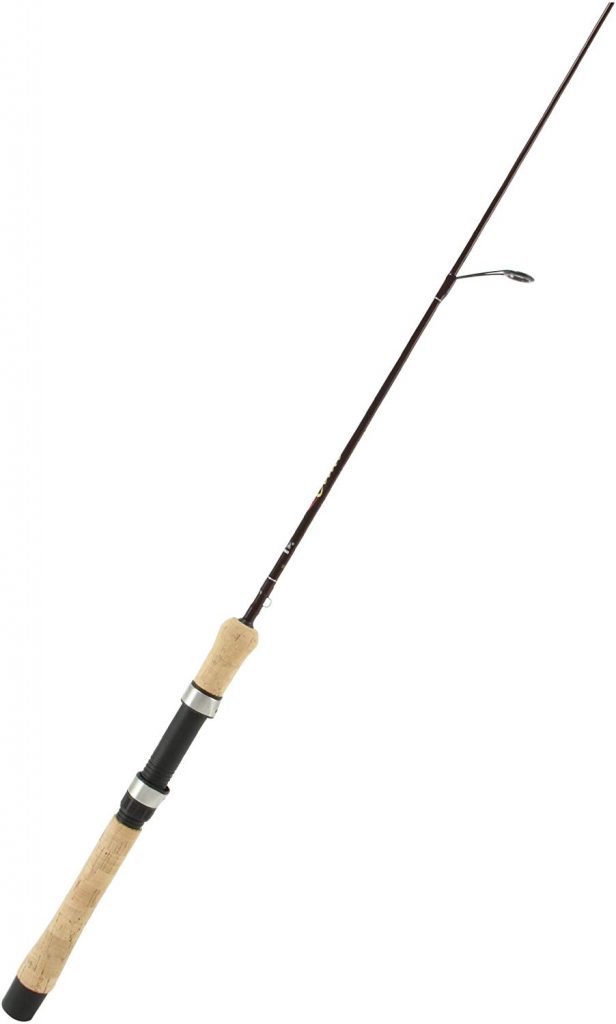
While the Ugly Stik Elite may only set you back $50, if you’re looking to save even more money then the OKUMA Celilo Graphite Lightweight Trout Rod is definitely worth a look. Usually selling for between $30 – $35, this is a great entry-level fishing rod that proves popular with those looking to dip their toe into the proverbial water for the first time.
Further cementing the Celilo’s status as a solid beginner’s model is the length. While its 8’6″ makes for some exceptional distance casting, it also makes accuracy a little trickier to master. Elsewhere, the cork-molded split handle makes for a comfortable grip and makes it all the more sensitive when a fish gets after your lure.
In terms of construction, the graphite material tends to be durable enough for occasional and lightweight use, but if you’re getting into some heavy-duty fishing this season then you may be better off investing more money in a stronger model as the cheaper construction can result in the tip snapping.
OKUMA Celilo Specifications:
- Material: Graphite
- Length: 8’6″
- Line Weight: 10 – 20lbs
- Handle type: Split
Ugly Stik Elite Pros:
- Best low-budget trout rod
- Great for distance casting
- Cork-molded split handle for comfortable holding
Ugly Stik Elite Cons:
- Cheaper construction than other leading models
- Only comes with one year warranty
Best Fishing Reels for Trout Fishing
Abu Garcia Revo SX Low Profile Fishing Reel
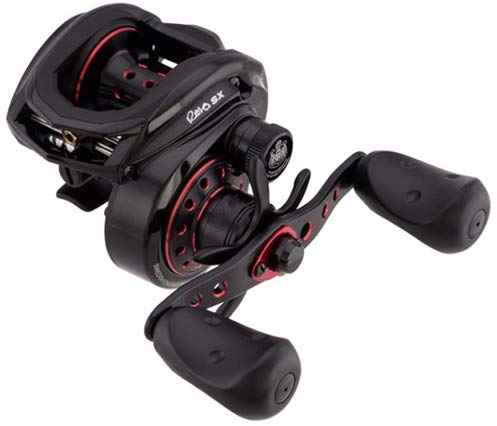
Much as with fishing rods themselves, the key to finding a good quality spinning reel for trout fishing is to find one that manages to be incredibly lightweight without sacrificing strength and durability. For our money, few do this better than the Abu Garcia Revo SX Low Profile Fishing Reel.
Despite weighing less than seven ounces, the Revo SX is impressively powerful, capable of dragging up twenty pounds, while the 6:2:1 gear ratio is optimized for quick retrievals. If there’s one thing we like best about the Revo SX, it’s the unique combination of nine stainless steel ball bearings and one roller bearing which makes it one of the smoothest performing reels on the market.
In fact, the only downside at all that we could find was the cost. Make no mistake about it, this is a pricey piece of kit, but if you’re looking to really make the most of this year’s trout fishing season, then it may be well worth the investment.
Abu Garcia Revo Specifications:
- Gear ratio: 6.2:1
- Maximum drag: 20 lbs
Abu Garcia Revo Pros:
- C6 carbon side plates for weight reduction
- Duragear brass gear for longlasting durability
Abu Garcia Revo Cons:
- More expensive than other quality models
Pflueger President Spinning Fishing Reel
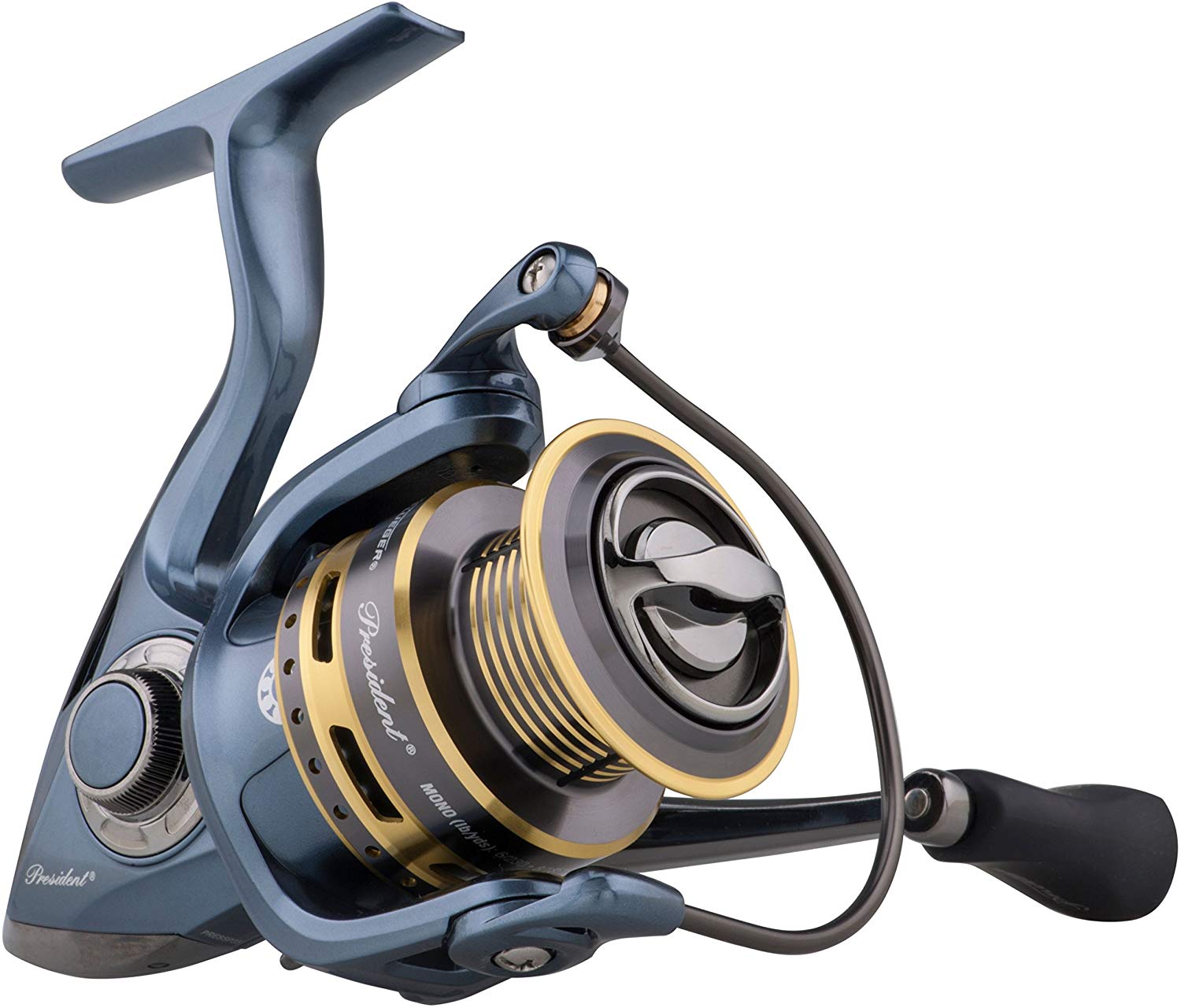
If the aforementioned Abu model is just a little out of your price range, then you might want to consider the Pflueger PRESSP30X. At almost half the price, this is a great budget-friendly model if you’re still exploring to see whether trout fishing is something you want to get more involved in.
As you might expect from a lower-cost model, the Pflueger President isn’t quite as strong as other options out there. Its maximum drag is limited to just nine pounds. To be honest, we expected more from a model that weighs just over eight pounds, but we’re glad to see that the 5:2:1 gear ratio does help you hold your own against larger fish.
We also like the solid aluminum spool which comes braid-ready, making it incredibly easy to use.
One final word of warning:
If you’re planning to find a fishing reel that you can use for both catching trout and heading out for a day of sea fishing, this isn’t going to work for you.
Though it offers a great deal for freshwater fishing, the Pflueger President is generally ill-suited to saltwater environments.
Pflueger President Specifications:
- Gear ratio: 5.2:1
- Maximum drag: 9 lbs
Pflueger President Pros:
- Best entry-level fishing reel
- Portable, lightweight design
Pflueger President Cons:
- Limited drag makes it unsuitable for catching larger trout
How to Catch Trout
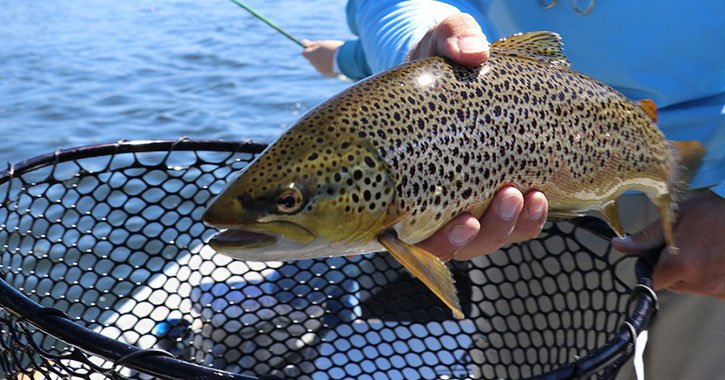
Now that you’re fully kitted out and ready to go, only one question remains:
How exactly do you use that equipment to catch trout?
Ask any seasoned fisherman about the best way to catch trout and the chances are you’ll get one of three answers:
- Bait fishing, lure fishing and fly fishing.
Each one has its pros and cons and is generally best suited for certain environments. Some old pros will tell you that the best route for beginners is to learn how to catch trout with bait, before progressing to lures and finally, having mastered the art form, going all-in with flies.
While there’s certainly an argument for that, there’s nothing to say that you can’t dive right into fly fishing if that’s really what works best for you. Here’s a breakdown of each type of fishing to help you determine which is the best approach for you.
Bait fishing
The oldest and perhaps the easiest approach to catching trout, bait fishing is ideal for newcomers as well as for those for whom the best part about the sport is the chance it affords you to sit back, relax and unwind. After placing your chosen bait on the end of your line and lowering it into the water, there’s nothing else to do but wait until a fish comes along and latches onto it.
Yet that doesn’t mean there isn’t an art to successful bait fishing. You’ll tend to find that different fish respond best to different types of bait and that the region you visit, as well as the time of year, can also play a factor. So there’s a challenge involved in figuring out which bait to use and when all of which is a big part of the fun.
Insects, aquatic worms and salmon eggs all make good bait options, though you might want to consider a good quality PowerBait formula like Berkely’s Natural Glitter PowerBait if you’re just starting out as it is particularly effective at catching large trout.
Lure Fishing
As the name suggests, lure fishing is literally luring fish in by tricking them with a small, toy-like device that replicates the movement of the kind of smaller creatures they like toe at.
Spoons, spinners, and soft worms are among some of the best lures for trout fishing, with spinners, in particular, proving the easiest to use for novice anglers. Again, it’s best to experiment with different types of lures to find the ones the fish in your area are most attracted to.
Fly Fishing
Fly fishing is perhaps the most popular way to catch trout and other freshwater fish, though it’s often the most expensive too. Similar to lure fishing, fly fishing uses a small tool that replicates a trout’s usual food source. However, whereas lures tend to mimic smaller fish, fly fishing uses tools that replicate insects.
Dry flies, such as the ones in this best-selling 120 piece set from Croch, tend to be very lightweight, requiring a heavier fishing wire and a longer rod to be effective. It’s this equipment which usually makes fly fishing pretty pricey, so if you’re still not 100% convinced that trout fishing is for you, you might want to try one of the other methods first.
On the other hand, fly fishing is usually the fastest way to catch trout, so it’s definitely worth considering if you’re serious about taking up the sport.
What are the Best US States for Trout Fishing?
Here’s a rundown of some of the best trout streams in the USA, each one perfect for your next fishing trip.
1: Colorado
Colorado proudly boasts that its waters are open for fishing right the year-round. While there are some restrictions in place, for the most part, this presents a perfect opportunity to enjoy some fantastic fishing even in quieter periods, beating the crowds and making the most of the open waters.
Yet this is far from the only reason that Colorada is such a top destination for trout fishing. The spectacular scenery of North Delany Lake, Gore Greek, and the world-renowned Frying Pan River all boast breathtaking scenery, making it a must-visit spot for any serious angler.
2: Arkansas
Much like Colorado, Arkansas offers some incredible scenery to capture your imagination while you wait for that fish to bite, but the real reason it makes our list here is the sheer abundance of fishing spots it has to offer.
All told, there are almost 10,000 miles of fishable waters in the southern state, with a plethora of rivers, lakes, and bayous all proving popular for trout fishing.
3: Montana
Montana remains one of our favorite destinations for catching trout thanks to the sheer variety of places there is to engage in some top quality fishing.
Be sure to load up your flying fishing vest if you’re visiting the famous Bighorn River, as fly fishing is the best way to catch the plentiful Brown and Rainbow Trout that live here.
Elsewhere, the Smith River is an ideal place to visit if you’re looking to fish as part of a wider camping or hunting trip.
4: Wyoming
Last but not least, Wyoming’s North Platte River earned the title of ‘Number One Big Fish Destination‘ according to American Angler Magazine thanks to the wealth of huge Rainbow, Brown, and Cutthroat trout to be found there.
Meanwhile, Yellowstone National Park is a veritable hotbed of top-notch fishing spots, with more lakes and streams per square mile than almost anywhere else.
More incredible fishing can be found in Grand Teton National Park and among the majestic Bighorn Mountains.
Where Will I Find Trout Fishing Near Me?
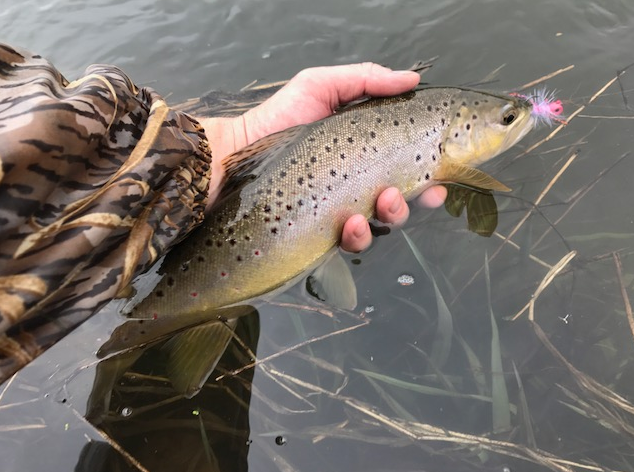
Even if your state doesn’t top any ‘Best Trout Fishing Destinations’ list, that doesn’t mean there aren’t great fishing opportunities to be had in your local waters. Again, contacting your local Fish and Wildlife Service should be your first port of call if you’re not sure where to go.
Alternatively, check-in with your nearest fishing tackle store and ask around. In our experience, the fishing community is generally a pretty friendly one, and you’ll usually find that most people you talk to are happy to recommend some great local fishing spots.
Where are the Best International Trout Fishing Destinations?
Of course, nobody says you have to stay close to home to enjoy some amazing fishing.
Sure, the US has some of the best locations in the world for catching trout, but you’ll also find some wonderful destinations across all four corners of the globe.
The Scottish Highlands
Scotland may be best known for its bagpipes, tartan, and unpredictable weather, but among those in the know, it also boasts a reputation as one of the world’s most popular trout fishing spots.
Surrounded by dramatic landscapes full of rolling hills, lush valleys and enchanted forests, the glistening lochs and boundless rivers are full of Brown Trout, making it an excellent choice for fly fishing.
Scotland’s trout fishing season typically runs from March to October, during which time you’ll find the best fishing spots in places like Rannoch Moor in Perthshire, along the world-famous Loch Level or in the further reaches of the country such as the Shetland and Orkney Isles.
Saskatchewan Province, Canada
Prefer to stay in North America rather than flying all the way to Europe for a spot of fishing?
With over 100,000 lakes and rivers, the Saskatchewan Province in Canada’s premier fly fishing destination, with more Rainbow and Lake Trout than you could ever possibly hope to catch in a single trip.
New Zealand
If you like your fly fishing with a good dose of sunshine, New Zealand’s North Island is the place to be.
Rainbow and Brown Trout both make their home among the vast lakes and flowing rivers, all of which are surrounded by truly captivating landscapes unlike anywhere else on earth.
Summing Up: You’re All Set to Fish
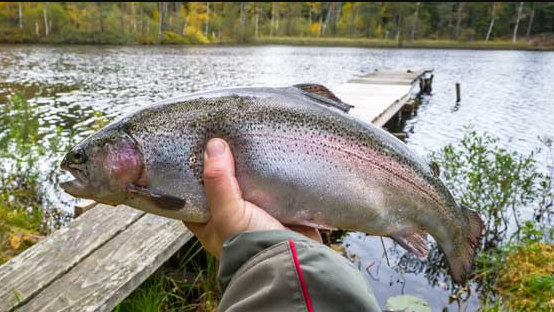
By now we’ve covered all of the most important aspects of learning how to catch trout and answered many of the most frequent trout fishing questions we’re asked by readers of River and Glen. Yet if there’s one thing more than anything else that we want you to take away from today’s guide, it’s this:
When it comes to trout fishing, you really do have a lot of options and all the freedom you could hope for in order to find an approach that works for you. For example, while we really enjoy the allure of lure fishing in open lakes surrounded by beautiful scenery and an air of tranquility, you may enjoy the rush of a fast-flowing river as you go all out with your fly fishing set-up.
How do you know which is the best approach for you?
Simple, you practice, experiment and explore. If you’re completely new to the sport, talk to the experts down at your local tackling store or find an active angling society in your area. You’ll find that the seasoned veterans are usually welcoming to newcomers and happy to pass on their advice.
Alternatively, start with the basics. Invest in a low-cost rod, reel, and line and have a go at bait fishing, which tends to be the cheapest way to get started. It won’t take long before you’re hooked (pun mostly intended) and can look at upgrading to lure or reel fishing depending on what’s best for your local area.
Above all else, relax and have fun with this. Though there’s few things more thrilling than catching the biggest fish of the day, it’s the experience as a whole that continues to attract millions of people each year to the joys of freshwater trout fishing.
If you’ve enjoyed this guide, you might enjoy our take on the best ways to catch other freshwater fish such as Bluegills or northern pikes. Alternatively, why not head out onto dry land and plan your next hunting adventure with our guide to the best hunting GPS units on the market?
Recommend Reads:
It’s always better to be prepared before the trout season begins, so here are some interesting gear articles you have to check before going fishing: